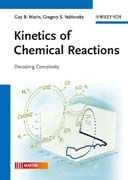
Kinetics of chemical reactions: decoding complexity
Marin, Guy
Yablonsky, Gregory S.
This systematic presentation covers both experimental and theoretical kineticmethods, as well as fundamental and applied. The identification of dominant reaction paths, reaction intermediates and rate-determining steps allows a quantification of the effects of reaction conditions and catalyst properties, providing guidelines for catalyst optimization. In addition, the form in which theequations are presented allows for their straightforward implementation for scale-up and chemical reactor design purposes. Throughout, the methodologies given are illustrated by many examples. INDICE: INTRODUCTION Decoding Complexity in Chemical Kinetics Three Types of Chemical Kinetics Challenges and Goals. How to Kill Chemical Complexity What our Book is not about. Our Book among other Books on Chemical Kinetics Logics in the Reasoning of this Book How Chemical Kinetics and Mathematics are Interwoven in this Book Brief History of Chemical Kinetics CHEMICAL REACTIONS AND COMPLEXITY Introduction Elementary Reactions and the Mass-Action Law The Reaction Rate and Net Rate of Production of a Component - A Big Difference Dimensions of the Kinetic Parameters and their Order of Magnitude Conclusions KINETIC EXPERIMENTS: CONCEPTS AND REALIZATIONS Introduction Experimental Requirements Material Balances Classification of Reactors for Kinetic Experiments Formal Analysis of Typical Ideal Reactors Kinetic-Model-Free Analysis Diagnostics of Kinetic Experiments in Heterogeneous Catalysis CHEMICAL BOOK-KEEPING: LINEAR ALGEBRA IN CHEMICAL KINETICS Basic Elements of Linear Algebra Linear Algebra and Complexity of Chemical Reactions Conclusions STEADY-STATE CHEMICAL KINETICS: APRIMER Introduction to Graph Theory Representation of Complex Mechanisms as Graphs How to Derive the Reaction Rate for a Complex Reaction The Derivation ofSteady-State Kinetic Equations for a Single-Route Mechanism - Examples The Derivation of Steady-State Kinetic Equations for Multi-Route Mechanisms - Kinetic Coupling STEADY-STATE CHEMICAL KINETICS: MACHINERY Analysis of Rate Equations Apparent Kinetic Parameters: Reaction Order and Activation Energy How to Reveal Mechanisms Based on Steady-State Kinetic Data Conclusions LINEAR AND NONLINEAR RELAXATION. STABILITY Introduction Relaxation in a Closed System Stability - General Concept Simplifications of Non-Steady-State Models NONLINEAR MECHANISMS. STEADY STATE AND DYNAMICS Critical Phenomena Isothermal Critical Effects in Heterogeneous Catalysis. Experimental Facts Ideal Simple Models: Steady State Ideal Simple Models: Dynamics Structure of the Detailed Mechanism and Critical Phenomena: Relationships Non-Ideal Factors Conclusions KINETIC POLYNOMIALS 'Linear' Introduction to the Nonlinear Problem: Reminder 'Nonlinear' Introduction Principles of the Approach: Quasi-Steady-State Approximation, Mathematical Basis Kinetic Polynomials: Derivation and Properties Kinetic Polynomials: Classical Approximations and Simplifications Application of Results of the Kinetic-Polynomial Theory: Cycles Across an Equilibrium Critical Simplification Concluding Remarks TEMPORAL ANALYSIS OF PRODUCTS: PRINCIPLES, APPLICATIONS AND THEORY Introduction The TAP Experiment Description and Operation of a TAP Reactor System Basic Principle of TAP The Position of TAP Among Other Kinetic Methods Qualitative TAP Data Analysis. Examples Quantitative TAP Data Description.Theoretical Analysis Kinetic Monitoring. Strategy of Interrogative Kinetics Theoretical Frontiers Conclusions: What is the Nearest Future? DECODING THE PAST Chemical Time and Intermediates. Early Hist
- ISBN: 978-3-527-31763-9
- Editorial: Wiley-VCH
- Encuadernacion: Cartoné
- Páginas: 428
- Fecha Publicación: 20/07/2011
- Nº Volúmenes: 1
- Idioma: Inglés
